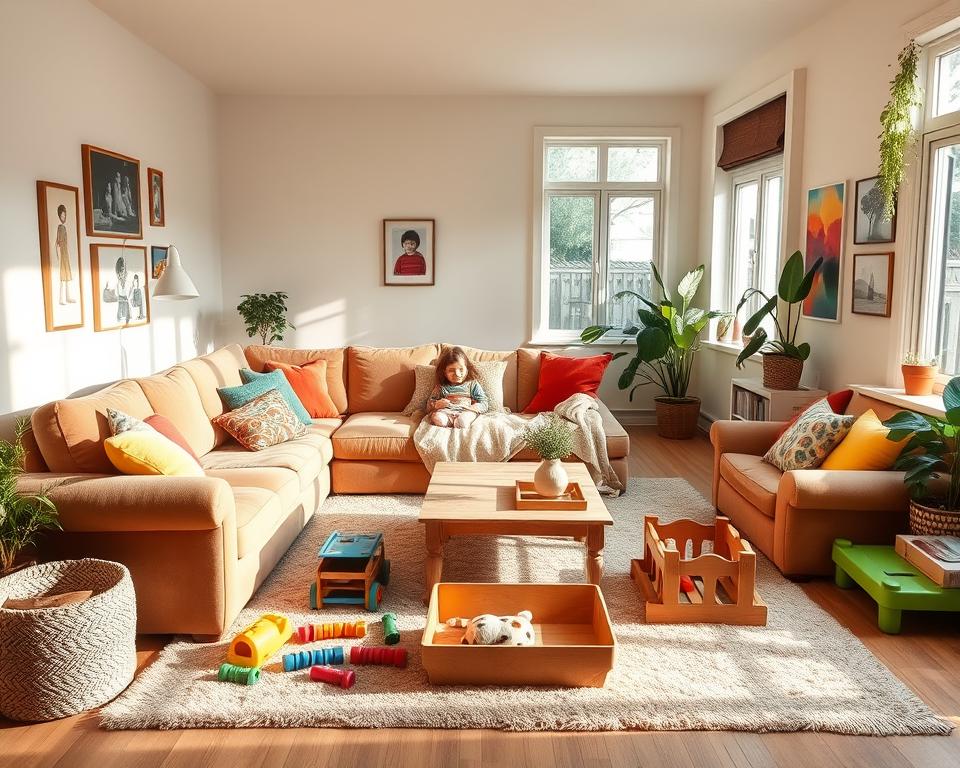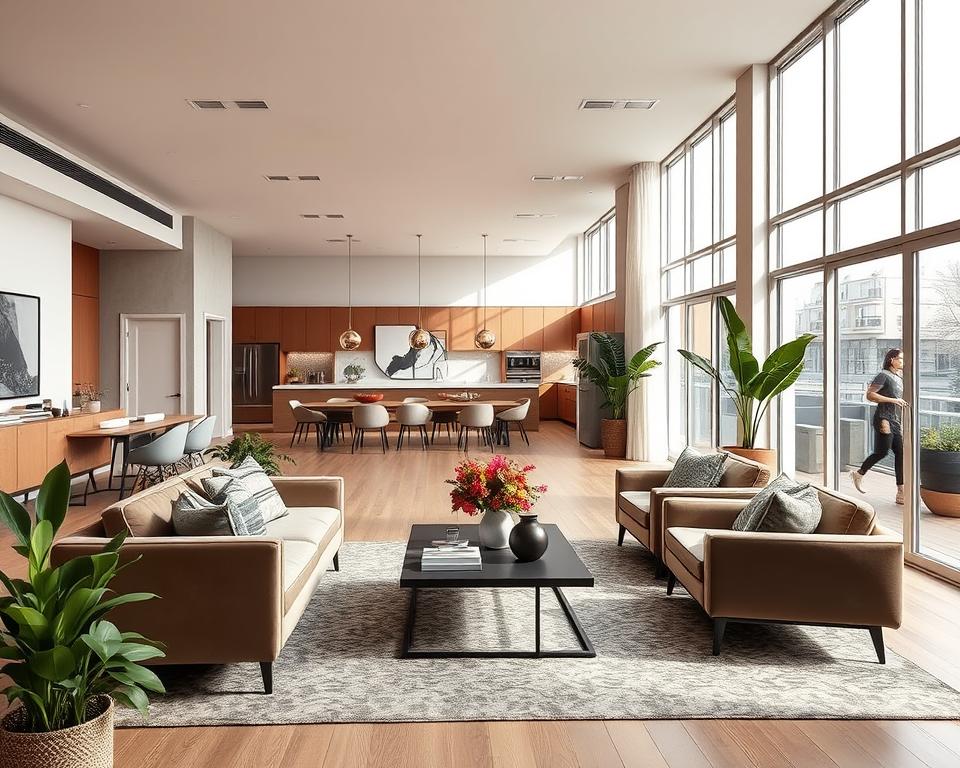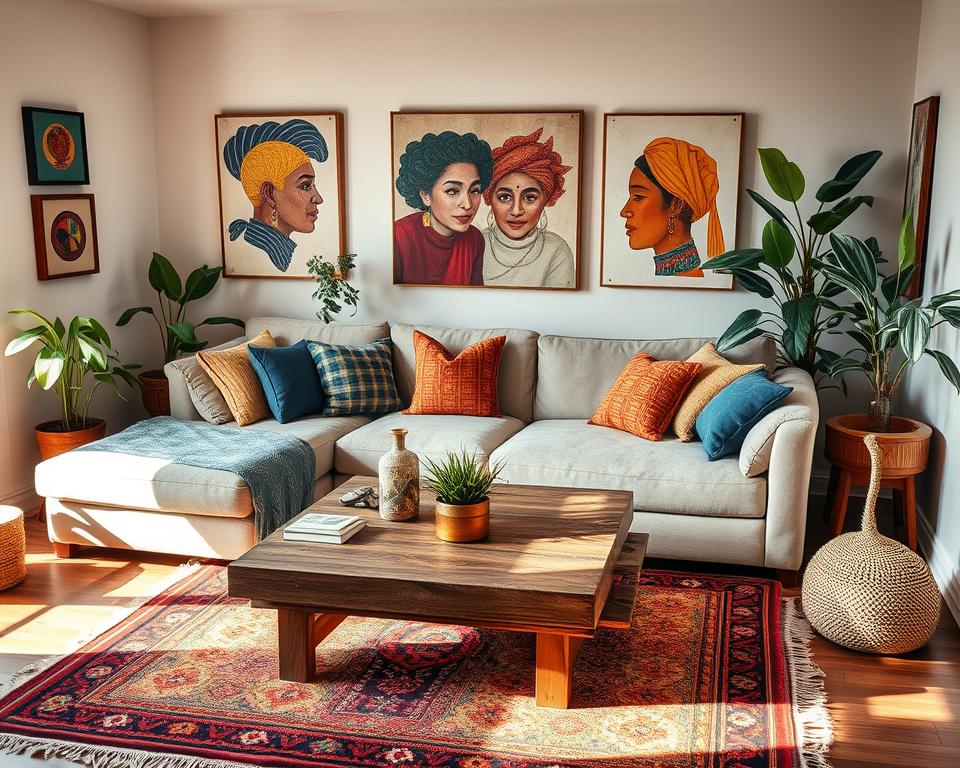Designing the perfect living room is a deeply personal endeavor, reflecting your unique lifestyle, personality, and aesthetic preferences. Gone are the days of one-size-fits-all decor solutions. In this comprehensive article, we’ll explore a range of living room decor ideas tailored to different demographics and styles, helping you create a space that truly resonates with you.
Key Takeaways
- Personalized living room design is essential for creating a space that reflects your unique lifestyle and personality.
- Different demographics, such as young professionals, families, and empty nesters, have distinct design needs and preferences.
- Explore tailored living room decor ideas for various demographics and styles to find the perfect fit for your home.
- Maximize small spaces and enhance open-concept living rooms with clever design solutions.
- Incorporate timeless and transitional elements to achieve a versatile and adaptable living room style.
The Importance of Personalized Living Room Design
In the realm of interior design, the one-size-fits-all approach simply doesn’t work when it comes to creating a living room that truly reflects your unique lifestyle and personality. Personalized living room design is the key to crafting a space that not only looks visually stunning but also feels like a true extension of who you are.
Why One-Size-Fits-All Doesn’t Work
Each individual has their own distinct preferences, needs, and design sensibilities. A living room that may work perfectly for one person might feel completely out of place for another. Generic, mass-produced furniture and decor often lack the nuance and attention to detail required to create a truly personalized living space.
Reflecting Your Unique Lifestyle and Personality
- Your living room should be a reflection of your personal style, hobbies, and the way you prefer to live.
- Whether you love to entertain, prioritize relaxation, or seek a multifunctional space, your living room design should cater to your specific needs and preferences.
- Incorporating unique pieces, custom-designed furnishings, and personalized accents can transform your living room into a space that feels like a true extension of your personality.
| Personalized Living Room Design | One-Size-Fits-All Approach |
|---|---|
| Tailored to your specific needs and preferences | Generic, mass-produced furniture and decor |
| Reflects your unique lifestyle and personality | Lacks the nuance and attention to detail required |
| Visually stunning and emotionally resonant | May feel out of place or impersonal |
By embracing the power of personalized living room design, you can create a space that not only looks beautiful but also serves as a true sanctuary that caters to your individual needs and preferences. This is the key to crafting a living room that you’ll truly love to spend time in.

Living Room Decor for Young Professionals
As young professionals strive to establish their career and personal lives, the living room decor plays a crucial role in reflecting their unique lifestyle and preferences. When it comes to living room design for this demographic, the focus is on creating a space that is both minimalist and functional, allowing for efficient use of space and a clutter-free aesthetic.
Minimalist and Functional Aesthetics
Young professionals often gravitate towards a minimalist living room design, opting for clean lines, neutral color palettes, and a streamlined look. This approach not only creates a visually appealing space but also helps to maximize the functionality of the room. Investing in multifunctional furniture and versatile decor pieces can be a game-changer, allowing them to personalize the space while maintaining a practical and organized living environment.
Incorporating Multifunctional Pieces
In a living room designed for young professionals, the incorporation of multifunctional pieces is essential. This could include convertible sofas, nesting tables, or storage ottomans that serve dual purposes, providing both seating and hidden storage. By carefully selecting these types of functional and minimalist living room decor items, young professionals can maximize the utility of their space while maintaining a clean and sophisticated aesthetic.

| Furniture | Features | Benefits |
|---|---|---|
| Convertible Sofa | Transforms from a sofa to a bed | Provides additional sleeping space for guests without taking up extra floor space |
| Nesting Tables | Compact design with multiple tables that fit inside one another | Offers versatile surface space that can be easily rearranged or tucked away when not in use |
| Storage Ottoman | Serves as a coffee table or extra seating with hidden storage compartment | Combines functionality and style, providing a practical solution for storing living room essentials |
By embracing a minimalist and functional approach to living room decor, young professionals can create a space that reflects their lifestyle and priorities, allowing them to enjoy a clutter-free and efficient living environment.
Family-Friendly Living Room Designs
Creating a living room that caters to the needs of families with children requires thoughtful planning and strategic design choices. When designing a family-friendly living room, the focus should be on balancing style, functionality, and safety to ensure a comfortable and inviting space for the entire household.
One of the key considerations when designing a family-friendly living room is the selection of durable, child-safe furnishings. Opting for fabrics and materials that can withstand the wear and tear of everyday life is essential. Stain-resistant and easy-to-clean fabrics, such as microfiber or performance-grade upholstery, can help maintain the room’s fresh appearance even with active children in the home.
Additionally, incorporating versatile and multifunctional pieces can enhance the livability of the space. Ottomans with hidden storage, coffee tables with rounded edges, and modular seating arrangements can accommodate a variety of activities, from playtime to movie nights, without compromising the overall aesthetic.
Creating a Cozy and Inviting Atmosphere
Beyond the practical considerations, family-friendly living room designs should also prioritize comfort and coziness. Soft, plush rugs, plentiful throw pillows, and cozy blankets can transform the space into a welcoming oasis for both children and adults. Incorporating child-friendly elements, such as colorful artwork or family-themed decor, can further enhance the sense of warmth and belonging.
| Feature | Benefit |
|---|---|
| Durable, child-safe fabrics | Withstand the wear and tear of everyday use |
| Versatile, multifunctional furniture | Accommodate a variety of activities and family needs |
| Cozy and inviting atmosphere | Create a welcoming and comfortable space for the entire family |
By prioritizing family-friendly design elements and creating a space that caters to the unique needs of households with children, you can transform your living room into a cherished hub of family life.

Living Room Decor for Empty Nesters
As the children have grown and flown the nest, empty nesters may find themselves seeking a living room that reflects their evolving lifestyle and newfound sense of freedom. The focus shifts from family-friendly functionality to embracing comfort and luxury, creating a cozy retreat that caters to their personal preferences.
Embracing Comfort and Luxury
Empty nesters often prioritize creating a living room that exudes a sense of relaxation and indulgence. Plush, oversized seating, such as deep sofas and sumptuous armchairs, provide a welcoming environment where they can sink in and unwind. Luxurious fabrics, like velvet and silk, add a touch of elegance, while warm lighting and soft, cozy textures enhance the overall ambiance.
Creating a Cozy Retreat
The living room becomes a personal oasis for empty nesters, a space to retreat from the world and savor the comforts of home. Layers of textiles, like throw blankets and decorative pillows, create a sense of coziness and warmth. Incorporating cozy nooks, such as a reading area with a comfortable chair and task lighting, allows them to indulge in their hobbies and interests.

By tailoring the living room decor to their unique needs and preferences, empty nesters can craft a space that truly reflects their stage of life and provides a sanctuary of comfort and luxury.
Living Room Decor for Specific Demographics
When it comes to living room decor, one size does not fit all. Each individual or household has unique preferences, lifestyles, and design needs that require a tailored approach. In this section, we’ll explore the diverse living room decor ideas that cater to a range of specific demographics, ensuring that your space truly reflects your distinct personality and way of living.
Design for Generation Z
The younger generation, often referred to as Generation Z, seeks living room designs that are both functional and visually stimulating. They prefer a minimalist aesthetic with clean lines, statement furniture pieces, and pops of vibrant color. Incorporating technology-friendly elements, such as built-in charging stations and multi-purpose furniture, can cater to their tech-savvy lifestyle.
Decor for Empty Nesters
As children grow up and move out, empty nesters often seek living room decor that promotes relaxation and comfort. Plush, oversized seating, cozy textiles, and a focus on personal mementos can create a warm and inviting atmosphere. Incorporating luxury elements, such as a sophisticated bar or wine storage, can also appeal to this demographic.
Multigenerational Considerations
Households with multiple generations often require living room designs that accommodate diverse needs and preferences. Incorporating flexible seating arrangements, adaptable lighting, and versatile storage solutions can ensure that the space functions seamlessly for both young and old. Bridging traditional and contemporary styles can also help create a harmonious and inclusive environment.
| Demographic | Living Room Design Priorities | Key Decor Elements |
|---|---|---|
| Generation Z | Functionality, Visual Stimulation | Minimalist Aesthetics, Bright Colors, Tech-Friendly Features |
| Empty Nesters | Comfort, Relaxation | Plush Seating, Cozy Textiles, Luxury Accents |
| Multigenerational Households | Adaptability, Inclusivity | Flexible Furniture, Versatile Storage, Harmonious Styles |
By understanding the unique needs and preferences of different demographics, you can create a living room that truly resonates with your individual lifestyle and personality. Tailoring your decor to specific demographics can help you achieve a space that is both visually appealing and highly functional.

Maximizing Small Spaces: Compact Living Room Solutions
When it comes to living room design, small spaces can present unique challenges, but they also offer opportunities to showcase your creativity and problem-solving skills. By carefully selecting space-saving furniture and implementing clever storage solutions, you can transform even the most compact living room into a functional and visually appealing haven.
Space-Saving Furniture and Layouts
In a small living room, every inch counts. Opt for multi-functional furniture pieces that serve dual purposes, such as coffee tables with hidden storage compartments or ottomans that double as both seating and extra storage. Leveraging vertical space with wall-mounted shelves or bookcases can also help maximize the available floor space.
When arranging your layout, consider a modular or sectional sofa that can be easily configured to fit the room’s dimensions. Alternatively, a loveseat or apartment-sized sofa can create a cozy and intimate seating area without overwhelming the space.
Clever Storage and Organization Ideas
Effective storage and organization are key to keeping a compact living room clutter-free and visually appealing. Utilize hidden storage solutions, such as ottomans with interior compartments or side tables with drawers, to stash away items that would otherwise clutter the room.
- Install floating shelves or wall-mounted cabinets to display decor and store books, magazines, and other accessories.
- Optimize unused spaces, like the area under the sofa or behind the TV, with custom-built storage solutions.
- Incorporate multipurpose pieces, such as a console table that can double as a media cabinet or a coffee table with built-in storage.

By thoughtfully selecting space-saving furniture and implementing clever storage strategies, you can transform a small living room into a harmonious and functional haven that reflects your personal style and lifestyle.
| Furniture Type | Space-Saving Features | Benefits |
|---|---|---|
| Sectional Sofa | Modular design, customizable configuration | Maximizes seating while optimizing floor space |
| Nested Tables | Compact nesting design, adjustable size | Provides extra surface area when needed, easily stored when not in use |
| Wall-Mounted Shelves | Utilizes vertical space, frees up floor space | Displays decor and stores items without taking up valuable floor area |
Enhancing Open-Concept Living Rooms
Open-concept living rooms have become increasingly popular in modern home design. These spacious, flowing layouts offer numerous benefits, such as a sense of openness, improved natural light, and better communication between different areas of the home. However, successfully navigating the design of an open-concept living room requires careful consideration of zoning and focal points.
Defining Zones and Focal Points
In an open-concept living room, it’s essential to establish distinct zones for different functions, such as seating, dining, and entertainment. This can be achieved through the strategic placement of furniture, area rugs, and lighting. By defining these zones, you can create a visually cohesive and functional living space that caters to your unique lifestyle and preferences.
Identifying a focal point is another key aspect of enhancing an open-concept living room. A focal point serves as the center of attention, drawing the eye and anchoring the overall design. This could be a striking fireplace, a large artwork, or even a statement pendant light. Arranging the furniture and accessories around this focal point helps to create a harmonious and visually appealing living environment.
| Design Element | Purpose |
|---|---|
| Zoning | Defining distinct areas for different functions within the open-concept living room |
| Focal Points | Identifying a central point of interest to anchor the overall design |
By thoughtfully defining zones and establishing focal points, you can transform your open-concept living room into a cohesive and visually captivating space that reflects your personal style and meets your practical needs.

Timeless and Transitional Living Room Styles
Designing a living room that stands the test of time can be a delightful challenge. By blending traditional and contemporary elements, you can create a space that is both timeless and transitional, allowing your living room styles to evolve with your changing preferences and lifestyle.
Blending Traditional and Contemporary Elements
To achieve a timeless and transitional living room style, consider incorporating a mix of traditional and contemporary furnishings and decor. For instance, pair a classic, tufted leather sofa with modern, minimalist side tables and a sleek, geometric area rug. This juxtaposition of old and new creates a balanced, visually interesting space that can adapt to various design trends over time.
Creating a Versatile and Adaptable Space
- Invest in versatile and adaptable pieces, such as a modular sectional or a coffee table with hidden storage, to easily reconfigure your living room as your needs change.
- Opt for neutral color palettes and timeless materials like wood, marble, and natural fabrics that can seamlessly transition between traditional and contemporary styles.
- Incorporate flexible lighting solutions, such as dimmable sconces and floor lamps, to set the perfect mood for any occasion.
| Traditional Living Room Styles | Contemporary Living Room Styles |
|---|---|
| Ornate, detailed furnishings Warm, earthy color palettes Antique or vintage accents |
Clean, minimalist lines Neutral, monochromatic tones Bold, statement-making pieces |
By blending timeless and transitional elements, you can create a versatile and adaptable living room that reflects your personal style and adapts to your changing needs over time.

Conclusion
In the world of living room decor, one size does not fit all. Whether you’re a young professional seeking a minimalist and functional aesthetic or an empty nester craving a cozy and luxurious retreat, the key to creating a truly personalized space lies in tailoring your design solutions to your unique lifestyle and preferences.
Throughout this article, we’ve explored the diverse needs and preferences of different demographics, from family-friendly designs to compact living room solutions for small spaces. By embracing personalized design, you can unlock the true potential of your living room, transforming it into a reflection of your individual style and a space that truly enhances your daily life.
As you embark on your living room decor journey, remember that the most successful designs are those that seamlessly blend function, aesthetics, and your personal touch. By incorporating the principles of tailored solutions and diverse demographics, you can create a living room that not only looks stunning but also serves as a warm and inviting haven that caters to your every need.

Leave a Reply